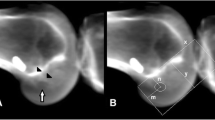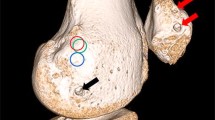Abstract
Objectives
To assess the feasibility and accuracy of frameless stereotactic two-dimensional fluoroscopy-assisted guide pin (GP) placement in posterior cruciate ligament (PCL) reconstruction in human cadavers.
Materials and methods
A total of 13 pins were placed in 7 cadaver specimens, using a fluoroscopic-based navigation technique. The knees were fixed noninvasively on a carbon baseplate. Interventions were planned on intraoperatively acquired perpendicular fluoroscopic images. A stereotactic aiming device was mounted to the carbon baseplate and adjusted according to the planned trajectories. GPs were advanced through the aiming device to the precalculated depth. GP positions were verified by image fusion of the fluoroscopic planning and control data, respectively. Measurements were scored on three occasions by one independent observer. In order to assess interobserver reliability, measurements were scored by two further independent observers on one occasion.
Results
The femoral cohort included seven GP placements in seven cadavers. Mean GP placement accuracy according to plan was 1.3 mm (SD 0.9 mm, range 0.3–3.8 mm) at the target point. The recorded femoral angular misalignment of GPs was 1.1° (SD 0.9°, range 0.2°–3.3°). The tibial cohort included six GP placements in six cadavers. Mean GP placement accuracy according to the plan was 1.8 mm (SD 2.1 mm, range 0.3–9.5 mm). The recorded tibial angular misalignment of GPs was 1.4° (SD 1.1°, range 0.1°–5°). Navigated GP implantation, as planned, was optimal in six out of seven cases in the femoral cohort and in four out of six cases in the tibial cohort.
Conclusion
Our preliminary cadaver study suggests that the use of fluoroscopic-based navigation combined with a stereotactic targeting device may be a helpful tool to improve PCL reconstruction. In addition, this method may also be used for other minimal invasive skeletal interventions.



Similar content being viewed by others
References
Ahn JH, Yoo JC, Wang JH (2005) Posterior cruciate ligament reconstruction: double-loop hamstring tendon autograft versus Achilles tendon allograft—clinical results of a minimum 2-year follow-up. Arthroscopy 21(8):965–969
Apsingi S, Bull AM, Deehan DJ, Amis AA (2009) Review: femoral tunnel placement for PCL reconstruction in relation to the PCL fibre bundle attachments. Knee Surg Sports Traumatol Arthrosc 17(6):652–659
Bale R, Widmann G (2007) Navigated CT-guided interventions. Minim Invasive Ther Allied Technol 16(4):196–204
Bale RJ, Kovacs P, Dolati B, Hinterleithner C, Rosenberger RE (2008) Stereotactic CT-guided percutaneous stabilization of posterior pelvic ring fractures: a preclinical cadaver study. J Vasc Interv Radiol 19(7):1093–1098
Bale RJ, Lottersberger C, Vogele M et al (2002) A novel vacuum device for extremity immobilisation during digital angiography: preliminary clinical experiences. Eur Radiol 12(12):2890–2894
Bergfeld JA, McAllister DR, Parker RD, Valdevit AD, Kambic HE (2001) A biomechanical comparison of posterior cruciate ligament reconstruction techniques. Am J Sports Med 29(2):129–136
Bland JM, Altman DG (1986) Statistical methods for assessing agreement between two methods of clinical measurement. Lancet 1(8476):307–310
Bland JM, Altman DG (1999) Measuring agreement in method comparison studies. Stat Methods Med Res 8(2):135–160
Bland JM, Altman DG (2003) Applying the right statistics: analyses of measurement studies. Ultrasound Obstet Gynecol 22(1):85–93
Chen CH (2007) Surgical treatment of posterior cruciate ligament injury. Chang Gung Med J 30(6):480–492
Christel P (2003) Basic principles for surgical reconstruction of the PCL in chronic posterior knee instability. Knee Surg Sports Traumatol Arthrosc 11(5):289–296
Fontbote CA, Sell TC, Laudner KG et al (2005) Neuromuscular and biomechanical adaptations of patients with isolated deficiency of the posterior cruciate ligament. Am J Sports Med 33(7):982–989
Grassmayr MJ, Parker DA, Coolican MR, Vanwanseele B (2007) Posterior cruciate ligament deficiency: biomechanical and biological consequences and the outcomes of conservative treatment A systematic review. J Sci Med Sport
Hoher J, Scheffler S, Weiler A (2003) Graft choice and graft fixation in PCL reconstruction. Knee Surg Sports Traumatol Arthrosc 11(5):297–306
Jäger A, Linke RD (2007) Verletzungen des hinteren Kreuzbands. Trauma Berufskrankh 9:301–308
Kantaras AT, Johnson DL (2002) The medial meniscal root as a landmark for tibial tunnel position in posterior cruciate ligament reconstruction. Arthroscopy 18(1):99–101
Kim SJ, Chang JH, Kang YH, Song DH, Park KY (2009) Clinical comparison of anteromedial versus anterolateral tibial tunnel direction for transtibial posterior cruciate ligament reconstruction: 2 to 8 years’ follow-up. Am J Sports Med 37(4):693–698
Koh J (2005) Computer-assisted navigation and anterior cruciate ligament reconstruction: accuracy and outcomes. Orthopedics 28(10 Suppl):S1283–S1287
MacGillivray JD, Stein BE, Park M, Allen AA, Wickiewicz TL, Warren RF (2006) Comparison of tibial inlay versus transtibial techniques for isolated posterior cruciate ligament reconstruction: minimum 2-year follow-up. Arthroscopy 22(3):320–328
Markolf KL, Feeley BT, Jackson SR, McAllister DR (2006) Where should the femoral tunnel of a posterior cruciate ligament reconstruction be placed to best restore anteroposterior laxity and ligament forces? Am J Sports Med 34(4):604–611
Markolf KL, McAllister DR, Young CR, McWilliams J, Oakes DA (2003) Biomechanical effects of medial-lateral tibial tunnel placement in posterior cruciate ligament reconstruction. J Orthop Res 21(1):177–182
Petersen W, Lenschow S, Weimann A, Strobel MJ (2006) Importance of femoral tunnel placement in double-bundle posterior cruciate ligament reconstruction: biomechanical analysis using a robotic/universal force-moment sensor testing system. Am J Sports Med 34(4):456–463
Petersen W, Zantop T (2006) Biomechanik des hinteren Kreuzbandes und der hinteren Instabilität. Athroskopie 19:207–214
Rosenberger RE, Bale RJ, Fink C et al (2002) Computer-assisted drilling of the lower extremity. Technique and indications. Unfallchirurg 105(4):353–358
Rosenberger RE, Dolati B, Larndorfer R, Blauth M, Krappinger D, Bale RJ (2009) Accuracy of minimally invasive navigated acetabular and iliosacral fracture stabilization using a targeting and noninvasive registration device. Arch Orthop Trauma Surg (Epub ahead of print)
Sarvestani A (2006) Basic principles of fluoro-navigation. In: Kempf I, Grosse A, Haarman HJTM, Seidel H, Taglang G (eds) Practice of intramedullary locked nails. Springer, Berlin, pp 243–247
Seon JK, Song EK (2006) Reconstruction of isolated posterior cruciate ligament injuries: a clinical comparison of the transtibial and tibial inlay techniques. Arthroscopy 22(1):27–32
Sudkamp NP, Haas NP (2000) New methods of cruciate ligament surgery. Chirurg 71(9):1024–1033
Wang CJ, Chen HS, Huang TW, Yuan LJ (2002) Outcome of surgical reconstruction for posterior cruciate and posterolateral instabilities of the knee. Injury 33(9):815–821
Weiler A, Jung TM, Strobel MJ (2006) Arthroscopic assisted posterior cruciate ligament reconstruction and posterolateral stabilisation using autologous hamstring tendon grafts. Unfallchirurg 109(1):61–71
Weimann A, Wolfert A, Zantop T, Eggers AK, Raschke M, Petersen W (2007) Reducing the “killer turn” in posterior cruciate ligament reconstruction by fixation level and smoothing the tibial aperture. Arthroscopy 23(10):1104–1111
Widmann G, Eisner W, Kovacs P et al (2008) Accuracy and clinical use of a novel aiming device for frameless stereotactic brain biopsy. Minim Invasive Neurosurg 51(6):361–369
Conflict of interest statement
No financial support of this project has occurred. Prof. Bale is a co-inventor of the Vertek targeting device and a co-shareholder in its financial returns.
Author information
Authors and Affiliations
Corresponding author
Rights and permissions
About this article
Cite this article
Rosenberger, R.E., Bale, R.J., Kneisl, C. et al. Two-dimensional fluoroscopic navigation in posterior cruciate ligament reconstruction: a preclinical cadaver study. Arch Orthop Trauma Surg 130, 971–976 (2010). https://doi.org/10.1007/s00402-009-1037-z
Received:
Published:
Issue Date:
DOI: https://doi.org/10.1007/s00402-009-1037-z




